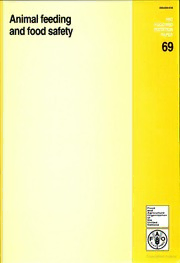
Animal feeding and food safety : report of an FAO Expert Consultation, Rome, 10-14 March 1997 PDF
Preview Animal feeding and food safety : report of an FAO Expert Consultation, Rome, 10-14 March 1997
Animalfeeding FAO FOODAND andfoodsafety otaAOUNFfhgrnanoargitdoiatidcneouidnlzstautrieon Copyrightedmaterial Animalfeeding FAO FOODAND andfood safety NUTRITION PAPER 69 ReportofanFAOExpertConsultation Rome,10-14March1997 Fanodod AOgrrgiacnuilztautrieon otUNfhnaeittieodns Rome,1998 Reprinted1999 oTpunhbeltihdceeastpiiagrotnnaodtfoitonhnoesteFimompoplldyoaytnehdedeAagxnrpdircetushlsetiuporrneesOoerfngatananytiizooapntiiontoinomnaotfwehrtaihaetlsUoinneivttheeirds afNrraoetniatoienorsrscooofrncbieotsrunnadiuantrhgoitreihste.ielse,galorstcatounsceortnainnygcotuhnetrdye,litmeirrtiattoiroyn,coiftyiotrs M-82 ISBN92-5-104158-X ArmcpVIleioenultapfcrrlyohrpierraieoimgvndsghaaieetlhtclstilaaoserlnnoye,TwdssDneteipeeerrvhxrvmimote.s,eteidono.Aodntcpir,NopoCploFttayiorrictpaoaahnancdtergsaitmlaoriolonentrafspdt.retoofhA0dtdoigh0ursrei1cirnpts0cwuiuu0ibaolcslnnthRei,uyc,orapsemtfewheiOorioo.rrtmungmhilIaosmdtnusaoalitibryyzo.enatb,htbayeiedowdnapirrrtneioehypofsrrastomehdpeedsueactrUnteamnosditi,,settsmhesieeedtonlonDetNricaerttooedrfficootninttoinshhrc,a,ee, ©FAO1998 Copyrightedmaterial 11L CONTENTS Page INTRODUCTION 1 RACKCiROIIND I SCOPE 2 INTERNATIONALTRADE 3 POTENTIALHA7ARTTSASSOCIATEDWITHFFFD 4 Mycotoxins 4 Infectiousagents 6 Transmissiblespongiformencephalopathiesinruminants 6 Salmonellaenterica 7 Toxoplasmagondii 7 Trichinellaspiralis 7 Veterinarydrugsandagriculturalandotherchemicals 8 Veterinarydrugs 8 Agriculturalandotherchemicals 8 SOURCESOFFEEDBQRNEHAZARDS 9 CQNTROL.QFFEEDBQRNE..HAZARDS LQ Transmissiblespongiformencephalopathies 10 Biologicalagents I Veterinarydrugs 1 Agriculturalchemicals 1 Mycotoxins II CONCLUSIONS 12 RECOMMENDATIONS 13 REFERENCES _ 14 ANNEXES 1. Listofparticipants 15 2. Draftcodeofpracticeforgoodanimalfeeding 17 3. Controlofhealthfactorsintheproductionofanimalfeeds:Anoverview 20 4. Infectionsandintoxicationsoffarmlivestockassociatedwithfeedandforage 28 5. CodexAlimentariusCommission-Standards,guidelinesandotherrecommendations relatedtothequalityandsafetyoffeedsandfoods 47 Copyrightedmaterial INTRODUCTION AnFAOExpertConsultationonAnimalFeedingandFoodSafetywasheldatFAO HeadquartersinRomefrom10to14March1997.TheConsultationparticipantsarelistedin ADinvniesixon1,.TwhheoCwonesluclotmateidonthweasparotpiecnipeadntbsyoMnr.beJhoahlnfLoufptiheen,DiDriercetcotro-rGoefneFrAaOl'osfFFoAoOd,anDdr.NuJtarciqtuieosn Diouf. Inwelcomingtheparticipants,Mr.LupienpointedoutthatFAOhashadalong-standing interestintherelationshipbetweenanimalfeeding,tradeandfoodsafety1.Overtheyearsproblems suchassalmonellaeandotherpathogenicmicro-organismsinfeed;aflatoxincontaminationinfeed affectingpoultry1andtroutandothermycotoxinproblems;contaminationoffeedswithpesticide residues,heavymetals,andindustrialchemicalshavecreatedconcernatnationalandinternational levels.Suchproblemscanposeriskstohumanhealthandsignificantdifficultiestotradeinfeedand infoodderivedfromanimals.Inthepastmanyfeedcomponentshavebeenhandledinwaysthat werenotdesignedtoassurethequalityandsafetyofthefinalfeed.Mostrecentlythelinkthathas beendrawnbetweenbovinespongiformencephalopathy(BSE)andfeedingredientshasgiven additionalimpetustowardsdevisingandenforcingstrictqualityandsafetycontrolproceduresinall stepsofproducing,processingandutilizationoffeeds. Mr.LupiensaidthatthereportofthisConsultationwillhelpFAOfurtherdevelop,atthe internationallevel,theoverallscientificbasisthatisessentialtothedevelopmentofimproved practicesinthefeedingofanimalsfortheproductionoffood.Arecommendedcodeofpracticefor goodanimalfeedingwouldimproveoverallfeedingpracticesandensurebetterqualityandsafer feeds,andbetterqualityandsaferanimalproductsforhumanconsumption.Thereportofthis ConsultationwillbeofvitalinteresttoFAO,itsmembergovernmentsandtheCodexAlimentarius Commission. TheConsultationelectedProfessorDavidFraserasChairmanandDr.JohnWilesmithas Vice-Chairman.Dr.KeithBehnkewasappointedasRapporteur.InhisopeningremarksProfessor Fraserpointedoutthatbecausethecostoffeedingwasthemajorexpenseinmanyanimal productionsystems,theanimalindustriesareconstantlyseekingnovelandcheaperfeeds,allof whichmayormaynotintroducenewcontaminantsintothefoodchain.Heexpressedthehopethat theConsultationwouldleadtotheformulationofacodeofpracticeforgoodanimalfeedingwhich wouldminimisehazardswhichmightarisefromfeedsduringlivestockproduction. BACKGROUND Foodproductionisacomplexprocess,withtheultimateobjectiveofthefoodindustryand foodsafetyregulatorsbeingtoensurethatfoodreachingtheconsumerissafeandwholesome. Foodgenerallyexpectedtobesafemaybecomeunsafeduetotheintroductionofhazardsduring production,processing,storage,transport,orfinalpreparationforconsumption.Forfoodderived Throughoutthisreport,‘food’meansanysubstance,whetherprocessed,semi-processedorraw,of animalorigin,whichisintendedforhumanconsumption,andincludesmilk.Theword'feed'means anysubstancewhetherprocessed,semi-processedorraw,whichisintendedforconsumptionby animalsfromwhichfoodisderived. 1 Copyrightedmaterial fromanimals,thehazardmayoriginatefromanumberoftheseandothersourcesincludingthe consumptionbyfoodproductionanimalsofcontaminatedfeed. Examplesofhazardsinfoodthatcanbelinkedtofeedandhavelongbeenrecognised includesalmonellosis,mycotoxicosis,andtheingestionofunacceptableresiduelevelsofveterinary drugsandagriculturalandindustrialchemicals.Inaddition,ifthepostulatedlinkbetweenBSEand thenewvariantofCrcutzfcldt-JakobDisease(nv-CJD)isestablished,itwouldbeanotherexample offoodcontaminationoriginatinginfeed. TwopaperswerecommissionedbyFAOfortheConsultation.Thefirstpaper(Annex3) addressesfeedprocessingandthesecondpaper(Annex4)addressesinfectionsandintoxicationsof farmlivestockassociatedwithfeedandforage. The Joint FAOAVHO Food Standards Programme, administered by the Codex AlimentariusCommission(CAC),hasalsodonesomeworkinthisareainthepast.Includedinits standards,guidelinesandotherrecommendationsarequalityandsafetystandardsformeatand variousmeatproducts,maximumlevelsforcontaminants,maximumresiduelevelsforresiduesof veterinarydrugsandpesticidesandcodesofpracticerangingfromhygienicpracticestouseand controlofveterinarydrugs.Annex5containsadescriptionandsummaryoftheCodexwork. SCOPE TheConsultationrestricteditsconsiderationstofoodsafetymattersthatpertainedstrictly tofeeds.Itdidnotconsiderplanttoxinsorradionuclides,nordiditconsiderparasitessuchas Taeniasaginalathatarespreadbyhumansewage.Inaddition,theriskstohumanhealthfromfeed orforagecontaminatedwithseveralotheragentssuchasBacillusanthracis, Clostridium botulinumtoxin,Listeriaspp.,MycobacteriumbovisandYersiniaspp.appeartobenegligibleor non-existentandwerethereforenotconsideredbytheConsultation.Italsodidnotconsider managementpracticesunrelatedtofeeding,suchasvaccinationorotherveterinarytreatments includingtheuseofinjectableagentsordrenches.Itdidnotconsiderspoilageoffoodproductsnor diditconsidernormalfeedingpracticesaimedatmaintaininggoodnutritionalstatusofproduction animals. Whiletherearcagreatmanyfoodsthatarcofanimalorigin,theConsultationrestrictedits consideration tothosefoodsfromcommondomestic animalswhichhavesignificancein internationaltrade.Theseincludemeatandmeatproducts,milkandmilkproducts,eggsandegg products,andproductsofaquaticanimalsderivedfromaquaculture.Allanimalfeedswere consideredotherthannaturalunrestrictedgrazing.TheConsultationlimiteditsconsiderationsto foodthatcomplieswithCACrecommendations,forexamplemeatjudgedtobefitforhuman consumptioninaccordancewiththeRecommendedInternationalCodeforAnte-mortemand Post-mortemInspectionofSlaughterAnimalsandforAnte-mortemandPost-mortemJudgement ofSlaughterAnimalsandMeat(CAC/RCP41-1993).Asoneexample,thisexcludedconsideration offoodborneanthrax. Aquacultureproductsareamajorsourceoffoodproteinindevelopingcountriesandone ofthefastestgrowingsystemsoffoodproduction.Therearctwobroadcategoriesofaquatic animalproduction.Oneinvolvestheproductionofcamivorous/omnivorousfishusingintensive farmingsystemsandislargelydependentupontheuseofcompoundedfeed,whiletheotheris 2 Copyrightedmaterial based on the mass production of herbivorous/filter feeding fish species within semi-intensivc/extensivefarmingsystemsbasedontheuseofagriculturalandotherby-products, includinganimalmanure,asfertilizerorsupplementaryfeedinputs.Intensivefishfarmingusing compoundedfeedthereforeclearlyfellwithinthescopeoftheConsultation.However,as semi-intensivc/extensivesystemsarcbeingconsideredbytheWHO/FAO/NACA1StudyGroupon FoodSafetyIssuesassociatedwithProductsfromAquaculture,thiswasnotconsidered. INTERNATIONALTRADE TheUruguayRoundofMultilateralTradeNegotiationsestablishedanewWorldTrade Organization(WTO)andincludednegotiationsonreducingnon-tariffbarrierstointernational trade. IncludedintheFinalActweretheAgreementsontheApplicationofSanitaryand PhytosanitaryMeasures(theSPSAgreement)andonTechnicalBarrierstoTrade(theTBT Agreement).BothAgreementshaveimplicationsfortheworkoftheCodexAlimentarius Commission. TheSPSAgreementconfirmstherightofWTOmembercountriestoapplymeasures necessarytoprotecthuman,animalandplantlifeandhealthprovidedthat“suchmeasuresarenot appliedinamannerwhichwouldconstituteameansofarbitraryorunjustifiablediscrimination betweencountrieswherethesameconditionsprevail,oradisguisedrestrictiononinternational trade"2. With respect to food safety, the SPS references the standards, guidelines and recommendationsestablishedbytheCACrelatingtofoodadditives,residuesofveterinarydrugs andpesticides,contaminants,methodsofsamplingandanalysis,andcodesandguidelinesof hygienicpractice. Therefore,measuresneedtobetakenwithrespecttofeedstoensureadherenceinfoodof animalorigintotheCodexmaximumlevelsorguidelinelevelsforcontaminants,andtotheCodex maximumresiduelimits(MRLs)forpesticideandveterinarydrugs.Measuresalsoneedtobetaken toensurethatappropriatehygienicpracticesarefollowedatallstagesoftheanimalfeedingchainto prevent,eliminateorreducepotentialhazardsinthefood. TheobjectiveoftheTBTAgreementistopreventtheuseofnationalorregionaltechnical requirements,orstandardsingeneral,asunjustifiedtechnicalbarrierstotrade.Itcoversalltypesof NACAisIheNetworkofAquacultureCentresintheAsia-PacificRegion. TheSPSAgreementdefinesSPSMeasuresasthosemeasuresapplied: toprotectanimalorplantlifeorhealthwithin[acountry's]territory....fromrisksarisingfrom theentry,establishmentorspreadofpests,diseases,disease-carryingorganismsordisease- causingorganisms; toprotecthumanoranimallifeorhealthwithintheterritoryof[acountry]fromrisksarising fromadditives,contaminants,toxinsordisease-causingorganismsinfoods,beveragesor feedstuff's, toprotecthumanlifeorhealthwithintheterritoryof(acountry]fromrisksarisingfromdiseases carriedbyanimals,plantsorproductsthereof,orfromtheentry,establishmentorspreadof pests;or topreventorlimitotherdamagewithintheterritoryof[acountry]fromtheentry,establishment orspreadofpests. 3 Thle On» 8CKN-C0Q-AH2H Copyrightedmaterial standards,includingallaspectsoffoodstandardsotherthanthoserelatedtoSPSmeasures,and includesaverylargenumberofmeasuresdesignedtoprotecttheconsumeragainstdeceptionand enuctornitoimoinaclfrreaquudi.reTmheentsa,spleacbteslloifngfaonoddmsettanhdoadrsdsofitancaolvyesriss.rTelhaeteTsBpeTciAfgicraelelymetnotqbuaasliictayllpyropvriosviiodnes,s thatalltechnicalrequirementsandregulationsmusthavealegitimatepurposeandthattheimpact orcostofimplementingthemeasuremustbeproportionaltothepurposeofthemeasure.Italso placesemphasisoninternationalstandards. TheConsultationrecognisedthatincreasedscientific,legalandpoliticaldemandsarebeing madeonthestandards,guidelinesandrecommendationselaboratedbyCodex.Thisisinpartdueto increasedconsumerinterestinfoodsafety,theWTO'sSPSandTBTAgreements,harmonization initiatives,callsforincreasedscientificrigour,theneedfortransparency,andshrinkingnational regulatoryresources.Therefore,acodeofpracticeforgoodanimalfeedingwasdraftedbythe Consultationwhichwouldfacilitateinternationaltradeinanimalfeedstuffsandanimalfood products, POTENTIALHAZARDSASSOCIATEDWITHFEED1 Mycotoxins Mycotoxinsaresecondarymetabolitesproducedbyfungiofvariousgenerawhenthey growonagriculturalproductsbeforeorafterharvestorduringtransportationorstorage.Some fungisuchasFusariumspp.typicallyinfestgrainsbeforeharvest,otherssuchasPenicilliumspp. caninvadegrainafterharvest,whileAspergillusspp.cangrowongrainsbothbeforeandafter harvest.Itmustbeemphasisedthatthepresenceofthefungidoesnotnecessarilyimplythat mycotoxinscanbefound.Conversely,theabsenceoffungidocsnotnecessarilymeantheabsence ofmycotoxins. Bothintrinsicandextrinsicfactorsinfluencefungalgrowthandmycotoxinproductionona givensubstrate.Theintrinsicfactorsincludewateractivity,pH,andredoxpotentialwhereas extrinsicfactorswhichinfluencemycotoxinproductionarerelativehumidity,temperatureand availabilityofoxygen. Manymycotoxins,w'ithdifferentchemicalstructuresandbiologicalactivities,havebeen identified.Mycotoxinsmaybecarcinogenic(e.g.aflatoxinBi,ochratoxinA,fumonisinBi), oestrogenic(zearalenoneandIandJzearalenols),neurotoxic(fumonisinB,),nephrotoxic (ochratoxins, citrinin, oosporeine), dermonecrotic (trichothecenes) or immunosuppressive (aflatoxinB,,ochratoxinA,andT-2toxin).Muchofthepublishedinformationontoxicityconcerns studiesinexperimentalanimalsandthesemaynotreflecttheireffectsinhumansandotheranimals. Inaddition,thesignificanceofthepresenceofmostmycotoxinsinfoodsofanimaloriginisnot completelyunderstood, Mycotoxinsareregularlyfoundinfeedingredientssuchasmaize,sorghumgrain,barley, wheat,ricemeal,cottonseedmeal,groundnutsandotherlegumes.Mostarerelativelystable Theorderofappearanceofcategoriesofhazardslisted(mycotoxinsetc.)isnotintendedtoindicate anyrankingofrelativeimportance. 4 Copyrightedmaterial compoundsandarenotdestroyedbyprocessingoffeedandmayevenbeconcentratedin screenings. Differentanimalspeciesmetabolisemycotoxinsindifferentways.Forexampleinpigs, ochratoxinAcanundergocntero-hcpaticcirculationandiseliminatedveryslowlywhileitisrapidly excretedbypoultryspecies.Thepolarmycotoxins,suchasfumonisins,tendtobeexcretedrapidly. Mycotoxins,ortheirmetabolites,canbedetectedinmeat,visceralorgans,milkandeggs. Theirconcentrationinfoodisusuallyconsiderablylowerthanthelevelspresentinthefeed consumedbytheanimalsandunlikelytocauseacuteintoxicationsinhumans.Howeverresiduesof carcinogenicmycotoxins,suchasaflatoxinBiandMi,andochratoxinA,whenpresentinanimal productsposeathreattohumanhealth,andtheirlevelsshouldbemonitoredandcontrolled. Inmostinstancestheprincipalsourceofmycotoxinsforhumansiscontaminatedcereals andlegumesratherthananimalproducts.Thismeansthattheexposuretomycotoxinsmaybe greaterindevelopingcountriesinwhichcerealgrainsandlegumesformthestapledietandthe intakeofanimalproducts,includingmeat,islow. Thereislittleinformationavailableregardingtheoccurrenceofmycotoxinresiduesin animalproductsintendedforhumanconsumption.SomeexamplesaresummarisedinTable1. Examplesofmaximumlevelsinforceinvariouscountriesinclude0.05-1ppbforaflatoxinMi,5 ppbforaflatoxinBi,25ppband50ppbochratoxinAinporcinekidneysandcerealsrespectively and,dependingonthecountry,30-1,000ppbforzearalcnoneincomandfoods(1).Thelevelsof mycotoxinsdetectedareusuallybelowthemaximumlevelsacceptedinmostcountries. 5 Copyrightedmaterial Table1.Examplesoffoodofanimaloriginwhichmaybenaturallycontaminated withmycotoxins Mycotoxin Potential Occurrence Maximum Reference effectson level humans reported AflatoxinBi Hepaticcancer Eggs 0.4ppb (2) Pigliver 0.5ppb (3) Pigmuscle 1.04ppb (4) Pigkidney 1.02ppb (4) AflatoxinM| t Cow'smilk 0.33ppb (5) OchratoxinA Renaldamage Pigliver 98ppb (6) Kidney 89ppb (7) Sausages 3.4ppb (7) Zeralenone Oestrogenic Pigliver 10ppb HI Pigmuscle 10ppb t ThereisinsufficientevidencetodescribeaflatoxinMlasahumancarcinogenalthoughitisapotent carcinogeninrodents. InfectiousAgents Transmissiblespongiformencephalopathiesinruminants Thetransmissible spongiform encephalopathies (TSEs) arenon-febrile neurological diseases.Theyhavealongincubationperiodandareultimatelyfatal.TSEsareassociatedwith incompletelydefinedagentscurrentlytermedprionswhichareresistanttonormalheattreatments offeedandfood.TheTSEsrecognisedinfoodproducinganimalsareBSEandscrapie.Sheep scrapiehasbeenrecognisedforover250years.BSEwasFirstrecognisedintheUKduring1986. TheBSEinfectiousagententersfeedprimarilythroughinfectedtissues(notablythecentralnervous systemandthereticuloendothelialsystem)renderedunderconditionsofinsufficientheattreatment toreducetheconcentrationoftheinfectiousagenttoanineffectivedose. Inthecaseofsheepscrapie,infectionisnaturallymaintainedbytransmissionbetween sheep.Itislikelythathumanshavebeenexposedtothescrapieagentbyeatingbrainandother tissuesfrominfectedsheepalthoughthereisnoevidencethattheoccurrenceofeitherCJDor nv-CJDhasbeenassociatedwithscrapie.WithrespecttoBSE,humanscanpotentiallybeexposed throughconsumptionoftheinfectedtissues.Theoccurrenceinhumansofnv-CJDhasraisedthe possibilityofanassociationwith(heBSEagent.Atpresent,withthelimitednumberofdiagnosed 6 Copyrightedmaterial
